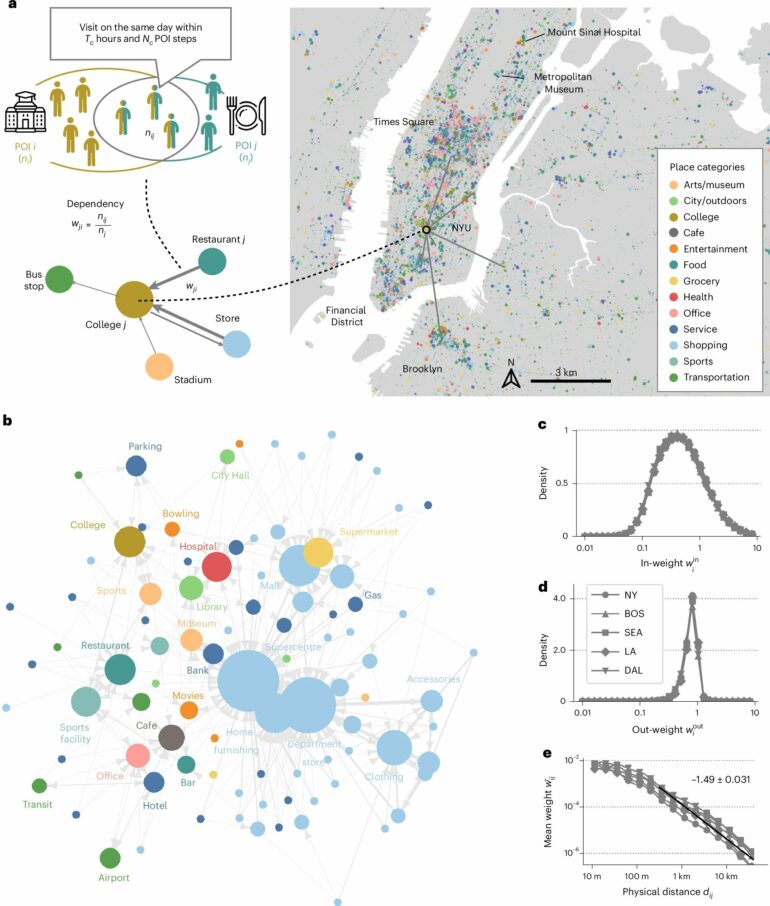With remote and hybrid work now an established norm, many restaurants located adjacent to office buildings are facing a permanent decline in foot traffic. But how will this behavioral shift ripple through businesses along commute routes? Does it trigger a chain reaction that extends far beyond the immediate vicinity of a commercial hub?
In a new paper published in Nature Human Behavior, a team of researchers led by NYU Tandon School of Engineering’s Takahiro Yabe and Northeastern University’s Esteban Moro have shown how connections between businesses stretch far beyond proximity when human behavior data is factored into the equation. The result shows that businesses—from gas stations to laundromats—can see large changes in their revenues, even if they’re not located in major business districts.
“Urban science views cities as complex adaptive systems, rather than entities that can be engineered with straightforward solutions,” says Yabe, Assistant Professor at the Department of Technology Management and Innovation and the Center for Urban Science and Progress.
“Our research contributes to understanding how changes in urban environments influence human behavior and economic dynamics. By focusing on dependencies between businesses and points of interest, we can help cities design more effective, equitable policies and infrastructure.”
Traditional models for measuring the interdependence of businesses largely rely on their physical proximity to one another. The research team, which also included researchers from the University of Pittsburgh and MIT—analyzed anonymized mobile phone data from over a million devices across New York, Boston, Los Angeles, Seattle, and Dallas, tracking how people move between businesses and other points of interest throughout the day. This allowed researchers to create detailed “dependency networks” showing how different establishments rely on each other’s customer base—and how far disruptions can spread.
This integration allowed them to refine predictions of business resilience during disruptions—such as those triggered by the COVID-19 pandemic—boosting accuracy by a staggering 40% compared to traditional models that relied solely on geographic proximity.
These networks revealed surprising patterns. While traditional models focused mainly on immediate neighbors—like a coffee shop next to a closed office building—the reality is far more complex. The study found that airports can significantly impact businesses up to 2.5–3.5 kilometers away, while even supercenters and colleges influence businesses within a 1.5-kilometer radius.
The researchers were also able to show how different types of establishments create varying ripple patterns. While shopping malls and colleges tend to have strong but localized effects, airports, stadiums, and theme parks can send economic shockwaves across entire urban areas. Perhaps most surprisingly, arts venues, restaurants, and service businesses can experience substantial impacts even when they’re far from the source of the disruption. This can provide key takeaways for people to design and run cities.
“This network has significant potential for urban planners and policymakers,” says Yabe. “For example, organizations like Business Improvement Districts (BIDs) can use it to identify synergies between parks and surrounding businesses, optimizing economic growth. Planners can also simulate the impacts of interventions, like congestion pricing or new infrastructure, to anticipate ripple effects throughout the city.”
Discover the latest in science, tech, and space with over 100,000 subscribers who rely on Phys.org for daily insights.
Sign up for our free newsletter and get updates on breakthroughs,
innovations, and research that matter—daily or weekly.
The publication is accompanied by an interactive visual dashboard, inviting users to simulate disruptions and observe how they impact a city’s economic landscape. Through a detailed map of POI’s in Boston, users can see exactly how much connectivity individual businesses have with those in their communities and beyond, and explore how business closures affect points far beyond their blocks or neighborhoods.
This research builds upon previous research of Yabe and his colleagues. Last year, they started a project on how EV chargers affect dining, shopping, and other activity patterns, and aim to provide policy makers with tools to support small and medium-sized businesses through their judicious placement. The project explores how and where charging stations should be placed to not only meet drivers’ needs but also enhance the economic resilience of local businesses and promote social equity.
The improved accuracy of business resilience predictions during disruptions such as pandemics or climate change-induced natural disasters is a crucial development for urban planners and policymakers working to strengthen the economic stability of cities. This insight makes a compelling case for shifting from a place-based to a network-based approach to planning and managing urban economies—one that recognizes that the health of a city’s economy is a web of interconnected threads.
The closure of an office or museum may seem like an isolated event, but within the tightly woven fabric of urban economies, it can reverberate with far-reaching effects.
More information:
Takahiro Yabe et al, Behaviour-based dependency networks between places shape urban economic resilience, Nature Human Behaviour (2024). DOI: 10.1038/s41562-024-02072-7
Provided by
NYU Tandon School of Engineering
Citation:
New research reveals economic ripple effects of business closures, remote work and other disruptions (2025, January 8)



